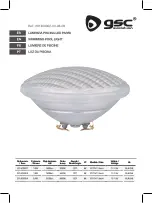
Page 21
ENGLISH
Jandy
®
Pro Series TruClear
™
Chlorine Generating System
|
Installation & Operation Manual
professional. Maintain ideal range of 30 - 50 ppm.
Follow your pool professional’s recommendations
and check all local and federal regulations to ensure
that the ideal range is suitable for your specific
conditions. For indoor pools, it is not necessary to
add chlorine stabilizer to the swimming pool water.
5.
Metals Test.
It is recommended that the pool water
be tested periodically for the presence of metals
such as iron, and manganese. These metals should
not be present in the pool water. If those metals are
present, contact your local pool professional.
6.3 Cleaning the Cell
CAUTION
Disconnect power to the system at the main circuit
breaker before performing this procedure to avoid
risk of electric shock which can result in property
damage, severe injury or death.
If the cell has a tendency to scale, it is recommended that
every month the cell be removed and inspected for scale
formation and/or debris. Some filters allow debris to pass
through to the cell which could lodge between the plates
in the cell. A small amount of scale formation is normal.
If by looking through the cell it is observed that there is
excessive scale formation between the plates or debris is
present, the cell must be cleaned as follows:
1.
Ensure that all power to the power pack and the
controller is turned off at the circuit breaker.
2.
Before removing the cell for cleaning, shut off any
necessary valves to prevent any water loss.
3. Open the air relief valve on the filter to release any
pressure in the pool system.
6.2 Monthly
1.
Check the cell.
It is recommended that the cell
be inspected every month for scale and/or calcium
deposits. Light colored, crusty deposits known
as scale will form in excessively hard water or
from pool water that is out of balance. Following
the installation of the Jandy Pro Series chlorine
generating device, check the cell once a month
for signs of scale. Hold the plate bundle to a light
source so the light can be seen between the plates.
If the light is easily seen through the plates and/or
a small amount of scale is visible, the cell does not
need to be cleaned. Reinstall.
On the other hand, if the light is barely visible
through the plates or the light is totally blocked by
scale, then the cell needs to be cleaned. See Section
6.3 for instructions.
NOTE
Excessive cleaning can shorten the life of your cell.
2.
Salt Level Test.
Use salinity test strips, a TDS/
salinity meter, or another reliable method to test the
salinity of the pool water. Once the existing salinity
has been established, use Table 1 to determine the
amount of salt to add to reach the desired level.
Be conservative when adding salt as it is easier to
add more if needed than it is to dilute if there is too
much salt. If the salinity level of the pool is correct
and the salt LED does not go out, see Section 7.
Troubleshooting.
3.
Pool Water Sample.
Take water sample to local
pool store for testing.
4.
Stabilizer (Cyanuric Acid).
Test pool water
stabilizer (cyanuric acid) level using a test kit
or by having a water sample tested by a pool
If your Total Hardness
(TH)* level is above
400 ppm or you reside
in an area known to
have hard water,
it is recommended you
change the polarity
reversal time from
the default of 5 hours
to every 3 hours
(instructions on back).
*Three (3) Total Hardness (TH) test strips are included
Areas known to have hard water
Figure 8.
Hard Water Map (Canada)
















































